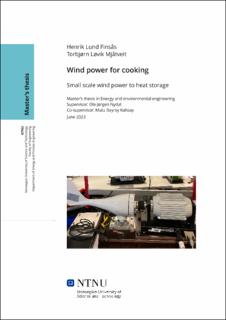| dc.description.abstract | Tilgangen på elektrisitet i Tanzania har det siste tiåret vært av de raskest voksende i
subsahariske Afrika, med en økende tilgang fra 7% til 37.7% mellom 2011 og 2020. Selv
om tilgangen i urbane områder har nådd 73.2%, har kun 24.5% tilgang utenom storbyene.
Dette skaper utfordringer og helserisikoer for daglige gjøremål, ettersom det i stor grad
benyttes kull og vedfyring til blant annet matlaging. Regjeringen i landet har satt et mål
om at det innen 2030 skal være tilgang på elektrisitet for hele befolkningen, hvorav 75%
skal være fra landets strømnett eller småskala strømnett, og de resterende 25% fra off-grid
løsninger.
Som et steg nærmere dette målet har dette prosjektet tatt for seg en hybrid off-grid
løsning, som kombinerer sol- og vindkraft til både elektrisitetsproduksjon og matlaging.
Ved bruk av en kontroller kan energien både gå til lading av et batteri, samt tillate
overskuddsstrøm å videreføres til et varmelager til bruk for matlaging. Dette gjøres for å
demonstrere termisk lagring av småskala vindkraft, både direkte og gjennom elektrisitet
ved bruk av batterier.
Ved å bruke en småskala vindturbin i prosjektet har disse konseptene blitt demonstrert
for å se hvordan en slik off-grid løsning kan anvendes for varmelagring. Opprinnelig var
turbinen plassert på taket av varmetekniske laboratorier ved NTNU, men grunnet dårlige
og intermitterende vindforhold ble den demontert. Videre testing ble dermed gjennomført
i laboratoriet ved varmeteknisk, hvor turbinen ble drevet ved bruk av en asynkronmaskin,
hvor dreiemoment og rotasjonshastighet kunne bli manuelt justert. Ønsket temperatur for
varmelageret ligger omkring 220°C, som vil kunne være tilstrekkelig for matlaging, men
temperaturer ble stoppet ved 100°C under testing for å demonstrere konseptet. Selve
varmelageret er en liten, isolert sylinder fylt med Duratherm 630 olje, hovedsakelig brukt
for demonstrasjon.
Det ble funnet fra en rekke tester at ved en effekt på 200W ut fra generatoren, ville en
motstand på 6Ω gi optimal effekt til varmelageret. Disse forsøkene ble gjennomført ved
bruk av en Tristar-kontroller og et lite varmelager. Ved forsøk gjort på direkte vind til
varme ble det observert at en optimal motstand ville ligge mellom 5 og 20Ω, avhengig av
vindhastighet. Ved å implementere et system som automatisk endrer motstanden blant
flere ulike settinger basert på dreiemomentet på turbinen kan nær optimal effekt oppnås
over varmelageret i de fleste driftsscenarioer. | |
| dc.description.abstract | Tanzania has experienced one of the fastest growing access rates to electricity in Sub-
Saharan countries for the past decade, with access increasing from 7% to 37.7% between
2011 and 2020. Although electricity access in urban areas has reached 73.2% in recent
years, only 24.5% in rural areas have access to electricity in their daily life. This causes
challenges and health hazards, as charcoal and wood are used for daily activities such as
cooking.
The government of Tanzania have set a goal by 2030 to achieve electricity access
to the entire county, 75% of which through national and mini-grids, and the remaining
25% from off-grid solutions. As a step towards this goal, this project aims to offer an off-grid hybrid system, combining wind and solar power for both electricity production and cooking. By the use of a
controller, diversion mode can be achieved, both charging a battery for electrical devices,
and diverting excess current to a dump load working as a heat storage. This is done to
demonstrate thermal storage of small scale wind power, both direct and indirect, via the
use of batteries.
Using a small scale wind turbine, these concepts on wind to heat have been demonstrated
to see how an off-grid solution based on wind power can be used for cooking. Originally,
the turbine was placed at the roof of the Thermal laboratory at NTNU, but due to poor
and intermittent wind conditions it was dismounted. Further testing were thus conducted
in the lab, where the turbine was driven by an asynchronous machine, where torque and
RPM could be set manually. Temperatures for heat storage are desired to reach 220°C,
which would be sufficient for boiling water and such, but for the purpose of demonstrating
heating using a wind turbine, temperatures were stopped at 100°C for the relevant tests.
The dump load used is a small, insulated cylinder filled with Duratherm 630 oil, used
mainly for demonstrative purposes.
It was found from a series of testing that with a power of up to 200W from the wind turbine
a resistance of around 6Ω for the dump load was optimal for maximum power to the heat
storage. These experiments were performed with the use of a Tristar controller and a
small heat storage. From demonstration of direct heating from wind it was found that an
optimal resistance would be between 5 and 20Ω, depending on incoming wind speed. By
having a system automatically switching the resistance configuration depending on the
torque shaft on the turbine, nearly optimal power could be achieved for the dump load
in most operation conditions.
For a final implementation of the system as an off-grid solution, a proper controller is
of great importance, enabling both wind and solar power as energy sources, as well as
protecting the turbine itself and possible batteries. An MPPT controller is a reliable
solution for this, optimizing the performance of a wind turbine. Several controllers offer
this, but don’t necessarily offer the same functioning for the PV panels, so this must be
kept in mind. A buck-boost converter can also be added in the system, enabling a stable
output voltage with a large range of input voltages. This would be especially practical for
the wind, as this is a more fluctuating and intermittent energy source than solar power.
For the time being, however, a Tristar controller is currently used in the setup, allowing
for both battery charging and heating of a dump load. | |
